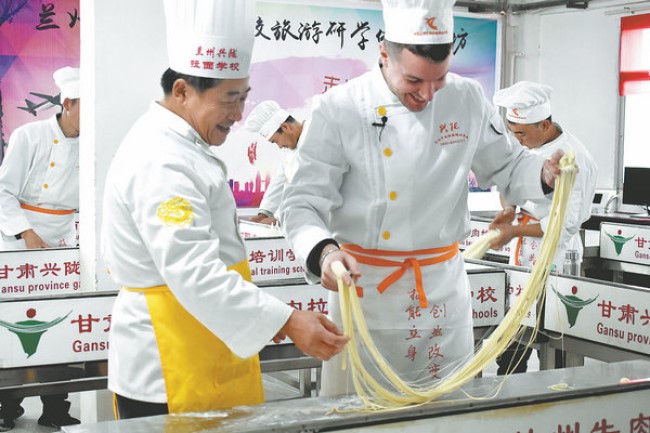National appetite for signature dish grows

Visitors from countries involved in the Belt and Road Initiative learn how to make Lanzhou beef noodles at a training school in Lanzhou, Gansu province. [Photo provided to China Daily]
Lanzhou beef noodles can be classified into more than 10 types based on their thickness, with each type having its own name. The noodle types are determined by the different age groups they are suitable for. For example, the thinner noodles are ideal for older people as they are easier to chew.
"This is why they are sometimes called 'longevity noodles'. The elderly feel happy when eating them and often consume them regularly. They are also suitable for children because of the softer taste," he says.
The thicker noodles are more suitable for younger people while the wider noodles may be loved by other individuals.
To enhance the flavor of the soup, more than 10 kinds of seasoning such as ginger peels, cumin and fennel seeds, and grass fruit are added.
In Lanzhou, noodle shops have their own recipes, giving rise to different styles of beef noodles across the city. Many of the well-known shop also have their own loyal patrons.
With some 500,000 shops in China and an estimated annual sales revenue of more than 400 billion yuan ($57.8 billion), Lanzhou beef noodles are also found abroad.
"Through continuous operation, innovation and development by generations of the Hui people, the Lanzhou noodles have gradually formed a unique style of clear soup, tender meat and thin noodles," Zhao says.
"The dish is a 'business card of Lanzhou' and has an inseparable relationship with residents and society and the local economy," he says.
Liang Shunjian, a renowned Lanzhou noodle chef, has been engaged in its professional education, international chain development, cultural promotion and new product research and development.
He founded Jinweide Lanzhou Beef Noodle in 1990, which has developed to covering the entire industry chain and aims to spread noodle culture and appreciation.
In 2007, Liang edited and published The Encyclopedia of Lanzhou Beef Noodles, which became the first professional technical book on the topic. Used widely in teaching and research, the book has become a must-read for those who want to understand the culture, learn the making techniques, and manage Lanzhou beef noodle shops.
In the same year, Liang also started the Gansu Xinlong Lanzhou Beef Noodle Vocational Training School to cultivate talent in the field. The school has trained thousands of students, including many from overseas. The noodle-experience workshop there has been selected as a research and practice education base for school students in Lanzhou.
In 2009, Liang went to Akita, Japan, for cultural exchanges as the "cultural ambassador" of Lanzhou beef noodles. In 2018, Jinweide introduced yak meat to further enhance the soup taste and it entered the overseas market by landing a store in Tokyo three years later.
Liang says their noodles have not only inherited the traditional beef soup style, but also feature a vegetable noodle that caters to the balanced nutritional needs of modern people.
"Using scientific and technological methods, we extract the juice from various green vegetables and mix it with egg and dough, then use hand-pulling techniques to make the noodles," Liang says.
The dish, with attributes such as being fast to consume, nutritious and delicious, represents the inheritance of Chinese culinary culture that is also going global.
Copyright © Lanzhou City, Gansu Province.
All rights reserved. Presented by China Daily.
Copyright © Lanzhou City, Gansu Province. All rights reserved. Presented by China Daily.




